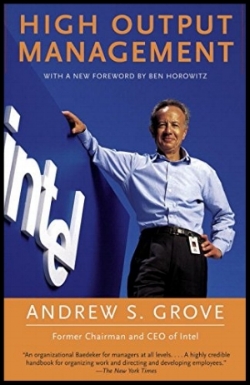The world is filled with mysteries and questions we may never know the answers too. Such as, why are we here on Earth, what is the purpose of our lives, and what do managers do?
Management is a complex but necessary part of any organization. It is an essential skill needed to create and maintain a business. However, most books lack clear actions and examples to help readers become better managers.
Under the Business & Money book category on Amazon, Management & Leadership is the 2nd largest category with over 290,000 titles.
Luckily, there's a book that serves as an excellent guide to navigating the world of management.
That book is High Output Management, by Andrew S. Grove.
Author Andrew S. Grove
If you haven't heard of Mr. Grove, here is a short summary.
He emigrated to the United States from Hungary because the country was occupied by Nazis. He arrived in New York and enrolled himself at the City College of New York despite not being able to speak English. He went on to get a Ph.D. from UC Berkeley. He helped build and run Intel as its president and CEO. He also taught at Stanford University Graduate School of Business for 24 years.
Grove's book has earned an almost legendary status. Ben Horowitz, the extremely successful entrepreneur and capital investor, says all the best managers know about the book, top venture capitalists give copies to their entrepreneurs, and aspiring leaders read it all the time.
In his book, Grove covers techniques for managing one's time, holding productive meetings, the proper way to train employees, and much more.
Below are only a few of the great lessons Andy Grove provides to readers:
1) Identify The Limiting Step In Your Activity
Groove starts his book in a unique way, by asking the reader to imagine they were a waiter serving breakfast. A customer asks for a boiled egg, toast and coffee.
What does this have to do with management?
Well whether you're making breakfast or microprocessors the principles are the same.
One of Grove's principles for better management is to identify the limiting step in your activity. The limiting step is the step in production that determines the overall shape of the operation.
In the breakfast example, the limiting step is the component that takes the longest to prepare. Since the coffee is already brewed and the toast only takes a minute, the answer is boiling the egg.
Since it takes the longest time to prepare, we should plan the entire job around the time needed to boil the egg. Grove provides a helpful diagram depicting the steps and time needed to make the breakfast.
“The key idea is that we construct our production flow by starting with the longest (or most difficult, or most sensitive, or most expensive) step and work our way back. ”
It would be inefficient to make the toast, pour the coffee, then boil the eggs because much more time would be spent and thus wasted. By identifying the limiting step and planning everything else around it, the process becomes much more effective.
The idea of a limiting step can also be applied to other scenarios, such as recruiting college graduates. To hire college graduates, Intel sends managers to visit colleges, conduct interviews and invites students to visit the company.
Intel pays the expenses (hotel, flight, etc.) for students visiting the company, therefore this becomes the most expensive and time-consuming part of the recruiting process. Thus, this becomes the limiting step for Intel.
Before issuing invitations to visit Intel, the company performs additional interviews by telephone to screen for the best candidates. This reduces the number of potential candidates that receive invitations to visit the company and therefore helps Intel save time and money.
2) Information Gathering Is Fundamental
According to Andy Grove, the three major kinds of managerial activities are: collecting information, conveying information and making decisions.
In order to conduct activities two and three well, a manager must first start by collecting information. There are a variety of ways to collect info. A manager can read books, magazines or visit sites online. They can also speak with analysts and customers. Andy however, favors a different method.
“The information most useful for me, and I suspect most useful to all managers, comes from quick, often casual verbal exchanges. This usually reaches a manager much faster than anything written down. And usually the more timely the information, the more valuable it is.”
Once a manager has gathered information, they must then convey it to others. A manager must communicate his objectives, priorities, and preferences. The last major task is decision-making. Grove points out that managers do make decisions every now and then but, the large part of their time is spent participating in the decision-making process rather than simply making decisions.
He continues by saying that the decision-making process depends on how well one comprehends the facts and issues facing the company. This ties back to the information gathering step. Conveying information and making decisions requires a base of information that a manager must have to face the issues, needs, and problems the company is facing.
“Information-gathering is the basis of all other managerial work, which is why I choose to spend so much of my day doing it.”
3) Delegate & Inspect
If you're successful at your job, you will be promoted to a manager. And as your team's performance increases, so will the number of employees you manage. As your team grows, you will have to review more of their work and delegate more tasks.
Given the choice, do you think it's better to delegate activities that you are familiar with or those that you aren't?
Grove believes the wise choice is to delegate tasks that you've done before. He says it is easier to monitor something which is familiar. Since you know about the task and how to perform it, you'll be better equipped to explain it to your subordinate. You'll also be able to see if they are performing the tasks correctly.
If you delegate tasks you aren't familiar with, it will be hard to know whether your employee is doing a good job or not.
After delegating, the next step is to inspect and monitor their work. Inspecting the work of your employees is similar to performing quality assurance tests in a production planet. The key is to monitor at the lowest-added-value stage of the process.
If you ran a furniture plant that made tables, you wouldn't make a table using rotten wood only to have customers say they won't buy it. Instead, you review the wood before you start production to make sure it will meet customer satisfaction.
The same principle can be applied to subordinates.
“Review rough drafts of reports…don’t wait until your subordinates have spent time polishing them into final form before you find out that you have a basic problem with the contents.”
As your employee's work gets better over time, decrease the time spent monitoring them.
4) Holding A Proper Meeting
Like going to the dentist or doing taxes, meetings have gained a reputation as an unpleasant but necessary part of life.
Before calling a meeting, it is important to identify what you're trying to accomplish. Make sure the meeting is necessary and justifiable.
“The chairman must have a clear understanding of the meeting’s objective–what needs to happen and what decision has to be made. The absolute truth is that if you don’t know what you want, you won’t get it.”
Grove writes that a manager's time plus overhead is about $100 per hour. So if a meeting involves ten managers and lasts two hours, it costs the company $2,000. If a single employee wanted to spend two grand on office equipment, they would most likely require approval from a supervisor. But, anyone can call a meeting and cost the company two-thousand dollars without any approval.
Meetings are an essential part of management.
The first step in calling a meeting is identifying who should attend and getting those people to commit to a time and place. The more people a meeting has the longer and harder it will be to accomplish the task at hand. Therefore, it is best to have no more than eight people in the meeting, say Grove.
The person organizing the meeting should send out an agenda of what will be discussed and what they hope to accomplish. The organizer must keep participants on track and on topic. If the task is accomplished early, end the meeting. If time is almost up but more discussion is needed, plan another meeting at a different date.
Once the meeting is over, send out an email summarizing the discussion that occurred, the decision made, and actions to be taken. Try to be as clear as possible, and tell participants what needs to be done, by whom, and by when.
5) The Importance Of Training
Andy begins his last chapter by talking about a new employee who was trained to operate a machine at their silicon fabrication plant. During the day, the machine shifted slightly out of tune, which resulted in defective finished products. Although the employee knew how to work the machine, she hadn't been taught to recognize the signs of an out-of-tune machine.
Grove says that by the time the situation was discovered, over a million dollars worth of material had been processed. It took two weeks to make up for the loss. This resulted in a delay in customer deliveries.
Whether you're a manager at a silicon fabrication plant or diner, proper training of employees is crucial to grow and maintain a successful business.
“Most managers seem to feel that training employees is a job that should be left to others, perhaps to training specialists. I, on the other hand, strongly believe that the manager should do it himself.”
Grove says that there are two ways a manager can raise the level of performance in their employees. The first is by increasing their motivation. The second is by increasing their capability, which is where training comes in.
Imagine a manager puts together 4-one hour training lectures for ten employees. Let's say it takes three hours to prepare for each lecture, therefore taking twelve hours in total to prepare. If those ten employees work full-time, then work approximately a combined total of twenty thousand hours for the company. If the training lectures result in even a 1% improvement in the subordinates' performance, the company will gain around two hundred hours of work as a result of the twelve hours the manager put in.
In other words, training can have an incredible ROI.
Grove goes on to say that Intel has a class catalog similar to that which you would find in a university. It lists over fifty different classes, ranging from proper telephone etiquette to complicated production courses. There are even classes for managers such as strategic planning.
Not only do employees learn new skills, the managers that teach often learn new things themselves. Preparing for lectures and presenting can improve the communication skills of a manager. Also, having to deal with a wide array of questions helps make the manager a master of their subject.
I hope you've enjoyed learning a few lessons from Andrew S. Grove's book, High Output Management. I recommend this book to anyone who manages employees (whether it's 1 or 1000+ employees). It is also great for entrepreneurs who wish to start their own company.
If you enjoyed this article, consider supporting our site or signing up for our monthly newsletter. Thank you!
Reader freebies:



































